Gran Canaria, because of its shape, is known as the round island of the Canary Islands. It is 47 km (29 miles) across and covers an area of 1,560 sq km. Its highest peak is Pozo de Las Nieves which is right in the centre of the island and is 1,949 meters above sea level.

North, South,and Centre!
Las Palmas, the island’s capital city is in the north. To the south, where it is usually a few degrees warmer is where most of the tourist resorts are.
The magnificent mountain ranges are in the centre of the island with their numerous villages, breathtaking scenery, sub-tropical vegetation, and varied wildlife. Here is where you will find the real, natural beauty of this incredible island.


During our visit on this occasion, we stayed for 10 weeks and hence had more time to travel around the island. Sometimes we used the local bus service and sometimes we hired a car. Getting around the island is very easy.
Here are our top 10 favourite places to visit in Gran Canaria based on our travels during this visit. I know we have only scratched the surface and we are very likely to add to the list when we visit next time but, for now, we hope they give you some inspiration to see more of the island the next time you visit!
In no particular order……
1 – PLAYA DEL INGLES
Our resort destination of choice when we visit Gran Canaria is usually Playa Del Ingles. For us, this place has the perfect mix for a great holiday. The climate is great all year, the sea is clean, there are miles of beautiful golden sands and there is enough varied nightlife to keep you entertained after dark.
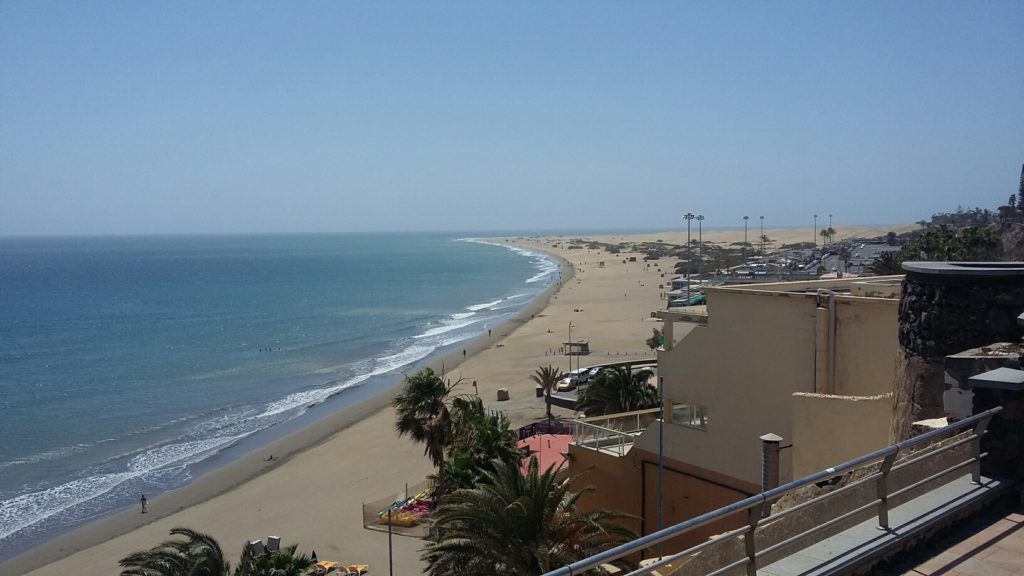
Playa del Ingles is a lively resort. It is located in the southeast of the island. It is quite a built-up area with plenty of high-rise hotels to accommodate the millions of tourists that visit every year.
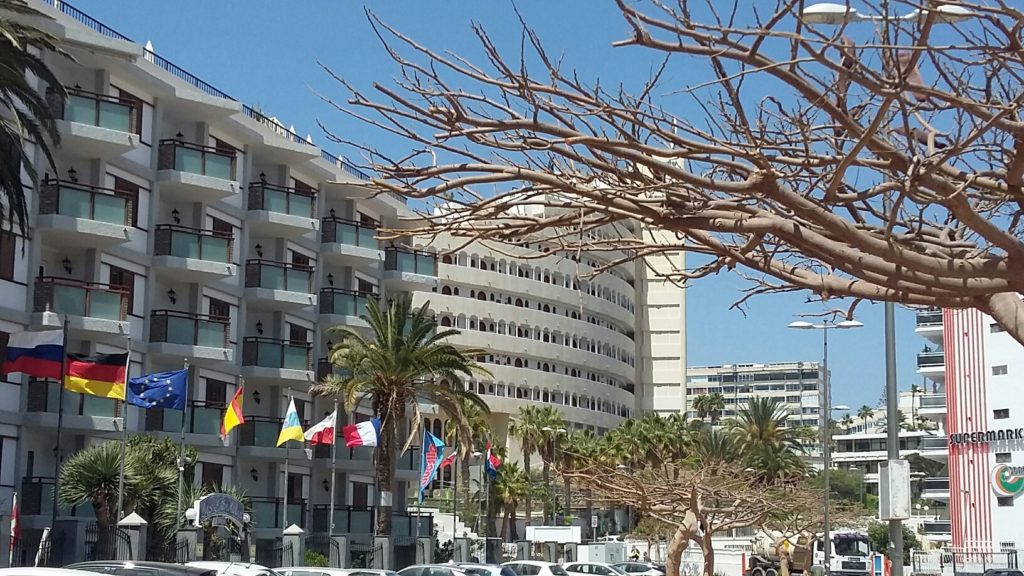
For entertainment, it is hard to beat with literally something for everyone. Children’s playgrounds, plenty of bars and restaurants, live music, dancing, golden sands, a long promenade for a run or walk and, as a bonus for us, it is a very gay-friendly resort.

The accommodation choice here is as wide as wide can be, from cheap self-catering apartments to up-market spa hotels with everything in between. It is an all-year resort because of its location close to the African coast and prevailing winds bring warm weather 12 months of the year. The UK winter is high season for the Canaries.
There are no airs and graces with this resort, it does not pretend to be anything that it is not. It is a fun holiday resort. A good time is guaranteed to everyone that stays here.
2 – MASPALOMAS
Maspalomas is the resort immediatly next to Playa del Ingles. There is plenty to do here but at the same time, It is much quieter than its lively neighbour. As it is only a 10-minute taxi ride away from Playa del Ingles it is an ideal destination for those that don’t want to be in a resort that is too lively.
The accommodation in Maspalomas tends to be low, two-story bungalows so it does not feel as built-up as its neighbour.
There is a lovely long promenade to stroll along. On one end of the promenade is an old lighthouse that has stood there since 1889
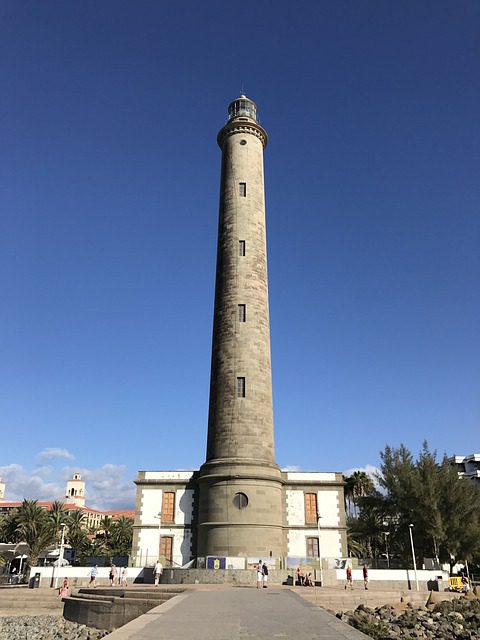
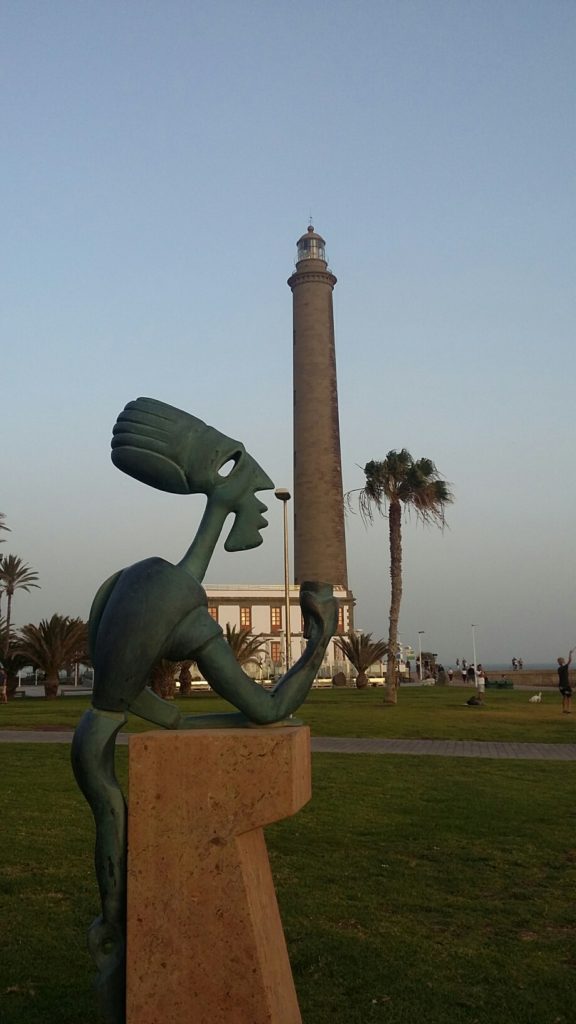
However, the main thing Maspalomas is most famous for is its amazing sand dunes. The dunes are set inside an enormous nature reserve that is made up of three eco-systems – Palms, Pond, and Dunes.

It is sometimes thought that the sand for the dunes came from the Sahara Desert. This is not true. During the ice age, the waters retreated leaving the sand visible. The winds then brought the sand to the shore. The winds blowing from the ocean are constantly moving the dunes. They can move up to five meters every year which means the scenery is ever-changing.

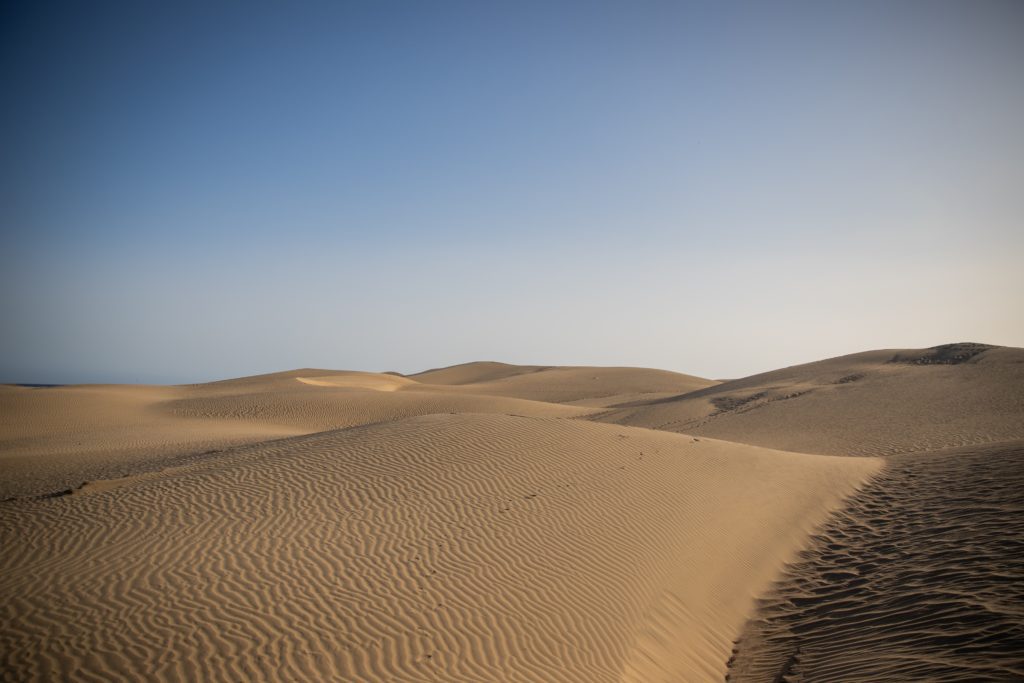
3 –PUERTO DE MOGAN
A drive ( or bus ride ) west along the coast will bring you to the picture-postcard town of Puerto de Mogan.

This is a fishing port and the marina is the main focal point of the town. It is a very pretty town that consists of rows of white-washed two-story buildings, most with roof terraces or small gardens that have beautiful bougainvillea plants hanging down giving large floral displays in the streets.
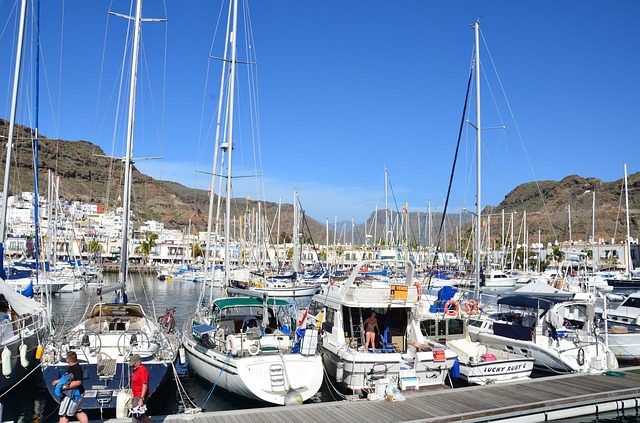
Mogan is known as the Venice of the Canaries. This is due to its canals that go under arches in the buildings linking the marina to the fishing harbour.
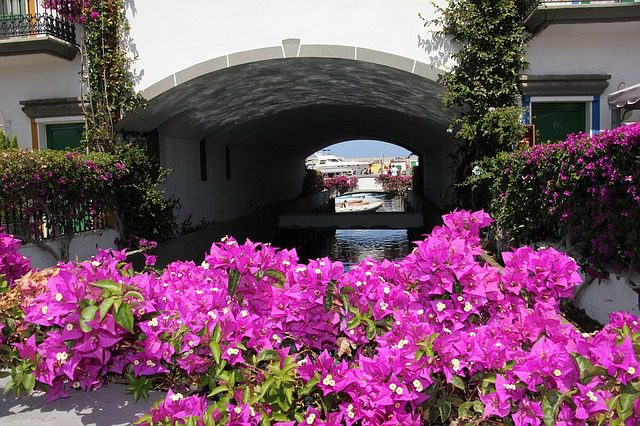
There is a small, sheltered beach here with crystal clear water. This is ideal for a cooling dip so don’t forget to take a towel. If you are more adventurous there are jet skis, parascending, sport-fishing excursions, and even a submarine trip that takes you out to a local wreck.

This town really is a jewel in the crown of Gran Canaria. I posted a couple of pics of our visit on a Gran Canaria facebook site and it had 657 likes! – my second most liked post ever (the top spot also goes to a town in this list! )
4 -VEGUETA
Walking the streets The 15th century-old town of Vegueta in Las Palmas is a great way to experience a Canarian town that is still full of original Spanish charm.
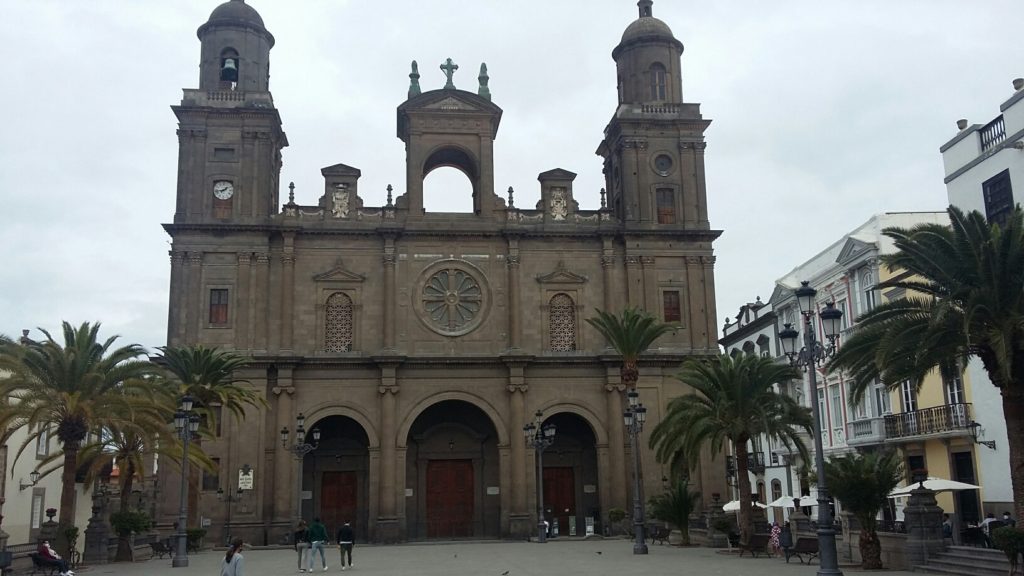
The capital city of Las Palmas is just 6 kilometers away and as there it developed to become the modern, vibrant city that it is today, Vegueta thankfully managed to keep much of its historical architectural beauty.
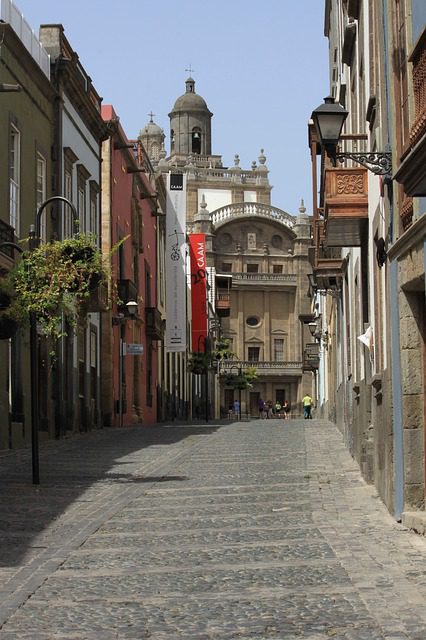


The whole area in Vegueta is mainly pedestrianised and so a lovely day can be had leisurely and aimlessly walking around admiring the beautiful houses, churches, shops, cafes and museums that line the cobblestoned streets
5 -PLAYA DE LAS CANTERAS
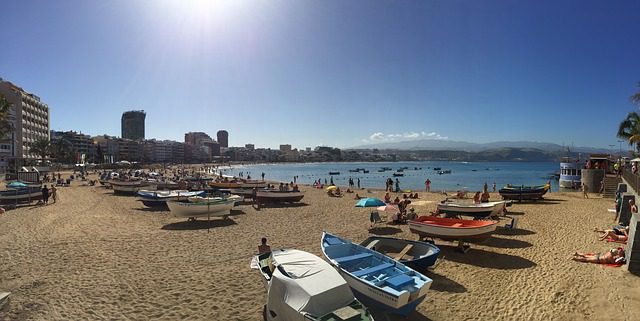
Las Canteras beach is the main beach area of the capital city of Las Palmas. As it is just a few steps away from the bustle of the city centre this is a real urban beach and I had a feeling that there were a lot more locals using this beach than those in the south of the island that is frequented mainly by tourists.
This area has It has a ‘cool’ feel to it with tourists mixing with hipsters mixing with locals mixing with surfers et al
An unusual feature of this beach is ‘La Barra’. A long rock formation that is in the sea not far from the beach. This protects much of the beach from tides making it very safe to swim. You can swim to the rock formation and walk along the rocks, from the beach it gives the impression that you are walking on water!
The beach stretches for miles and has a lovey well maintained promenade that follows it for the walkers. The sea at the far end of the beach has great conditions for surfing so is really popular for surfers of all abilities.

A great way to spend a day is to take a walk along the promenade that follows the contours of the coast. It is lined with shops, cafes, ice cream parlors, and restaurants that come in handy for welcome breaks as it goes on for miles
I was really impressed by how well maintained and clean this area was. Even the recycling bins are beach hut themed!
6 -TEROR
The pretty town of Teror is well worth a visit. It stands in the mountains approximately 550mtrs above sea level and 20 kilometers from Las Palmas.
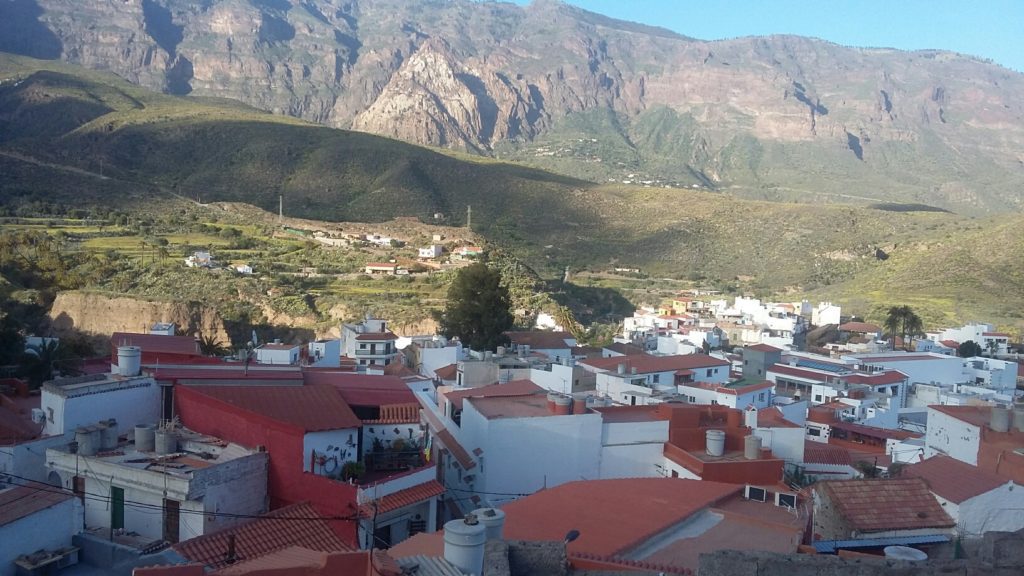
The church of Basilica the Virgen del Pino, Patron Saint of the Canary Islands is the most important building. Its construction dates back to 1767 and it stands in the central Plaza del Pino.
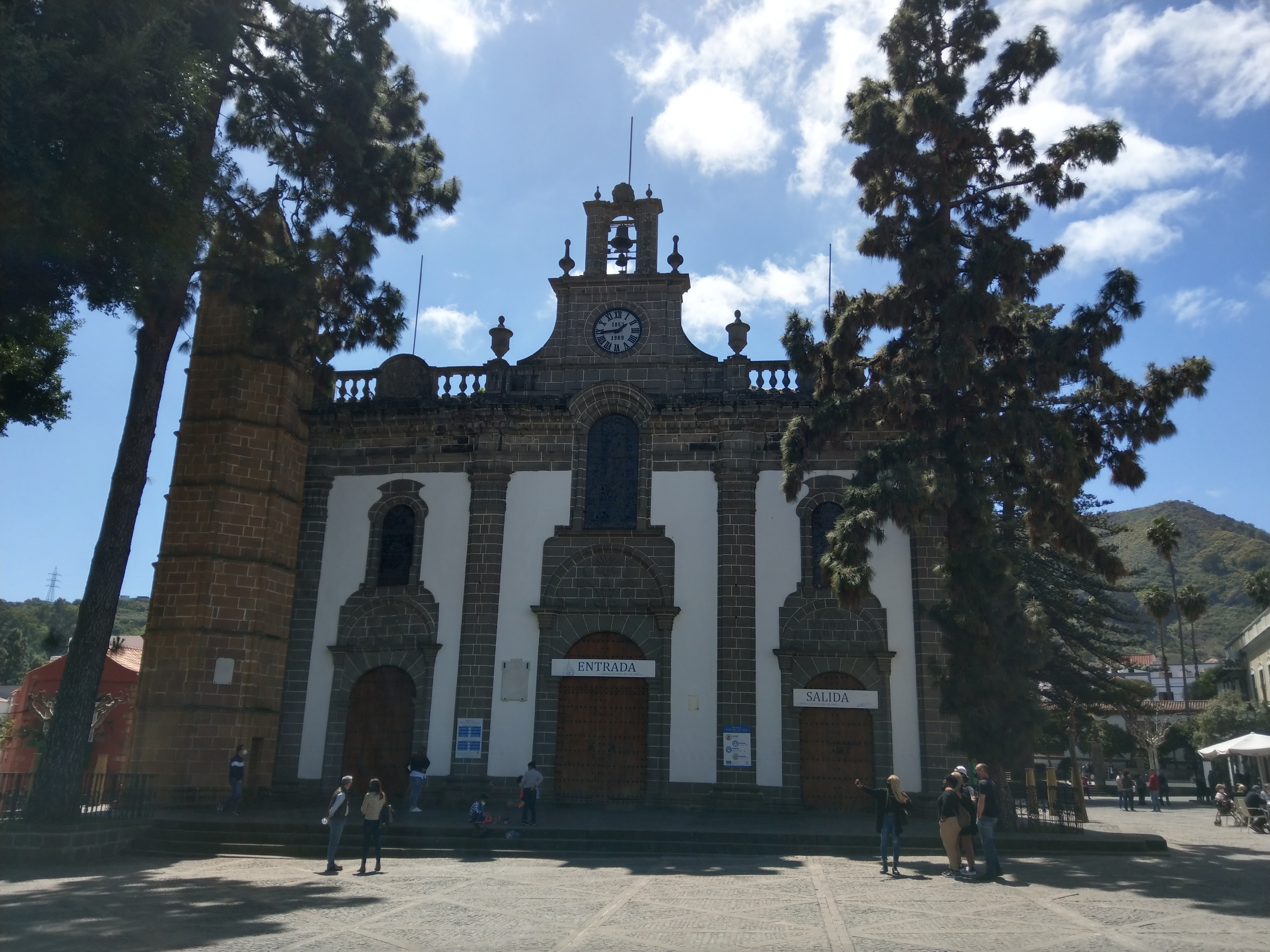
The historic central square and pleasant walks are very well maintained and you will find many things of interest including museums and fine examples of beautiful Canarian houses with their typical balconies,
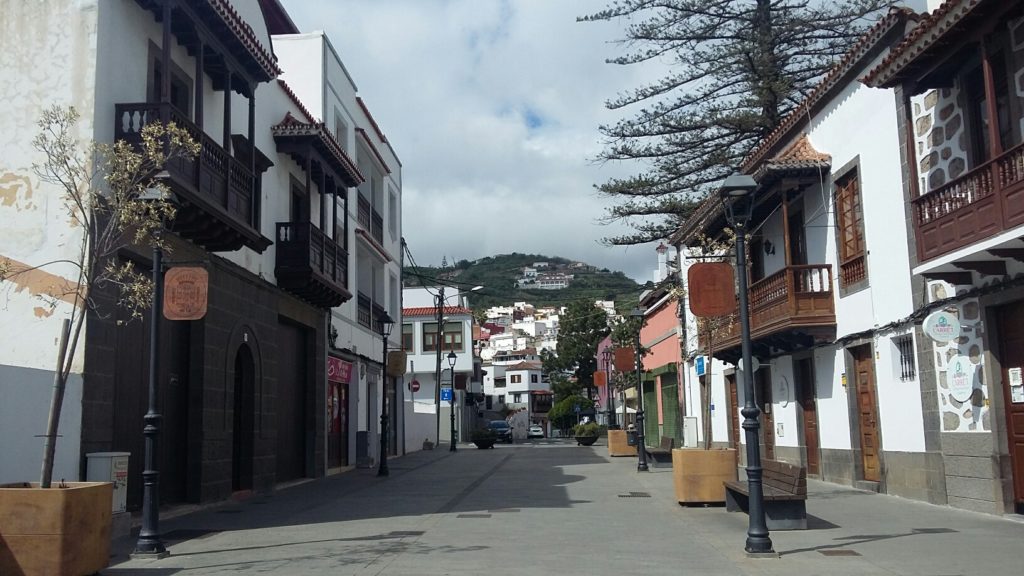
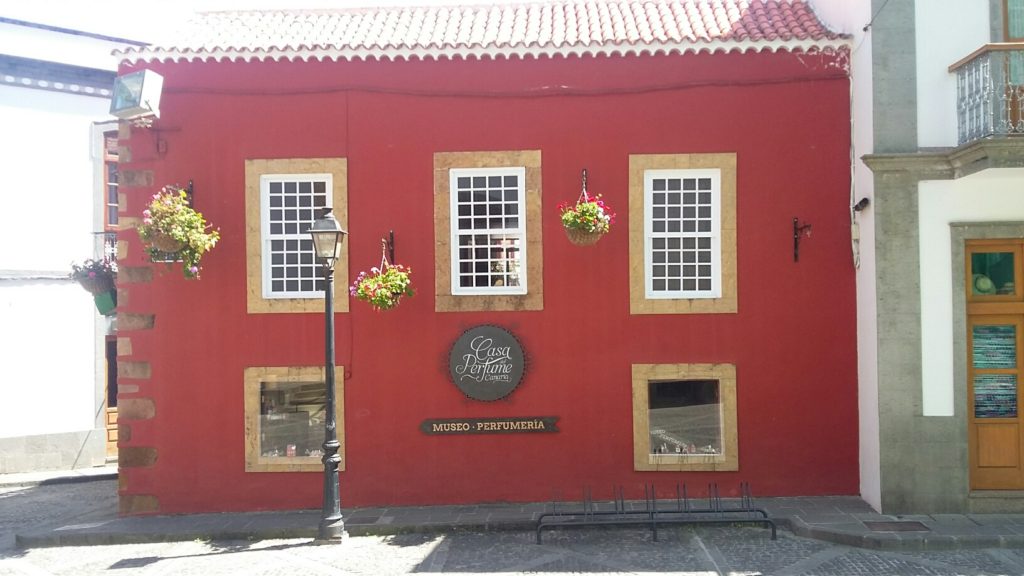
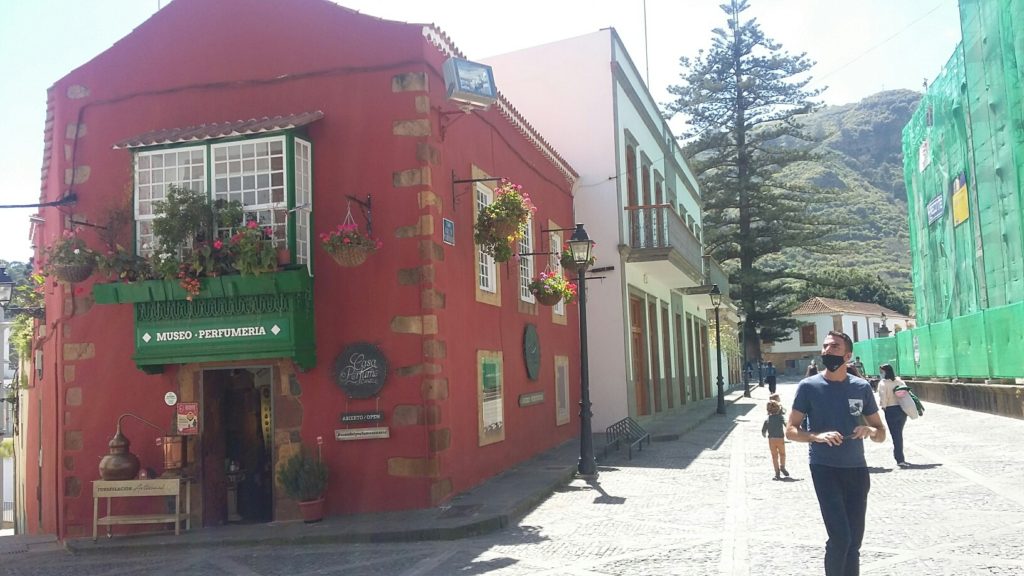
All this set with a magnificent backdrop of the mountain views make this an ideal place to stop for a while.
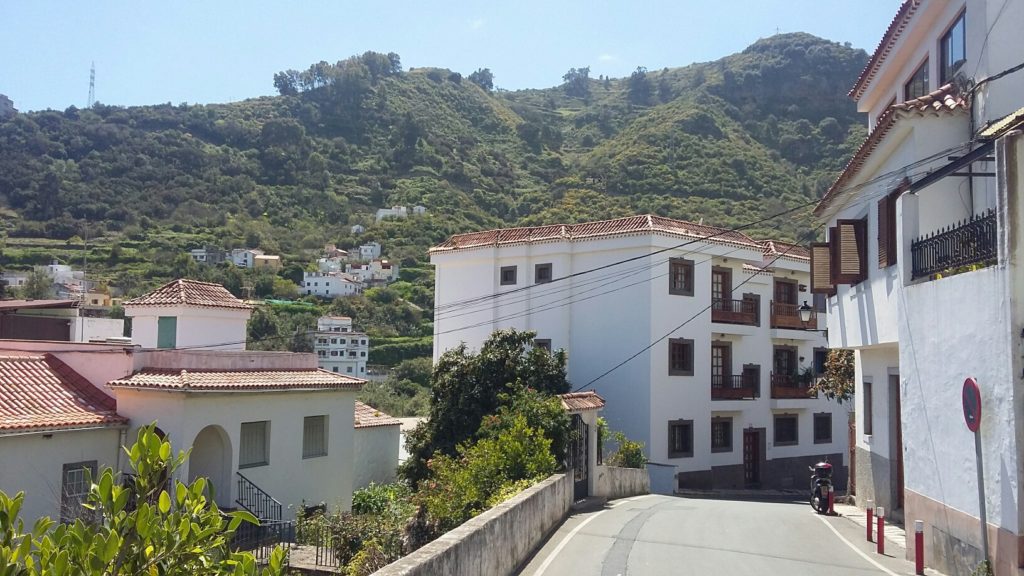
7 – FATAGANA
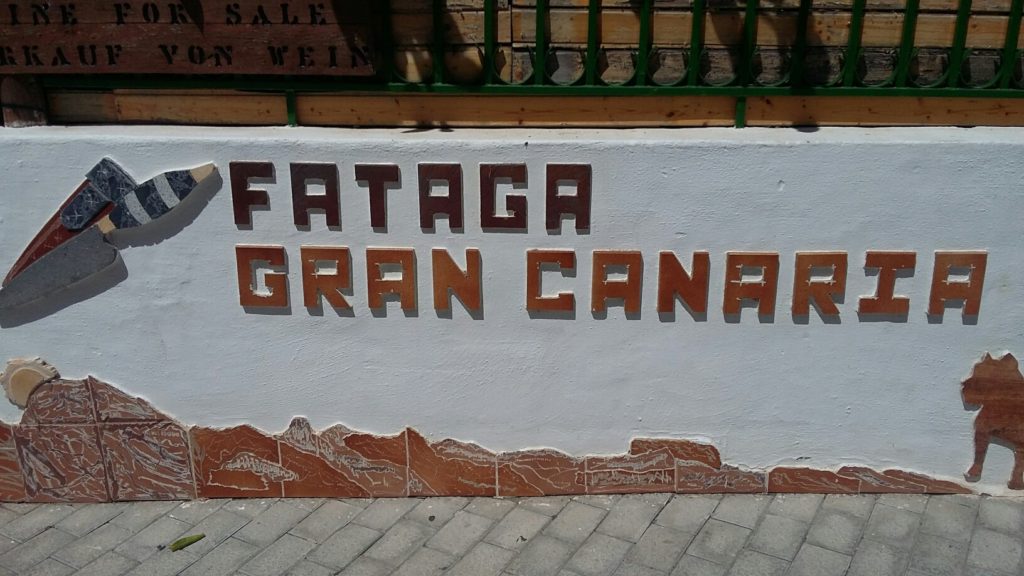
As is often the case we were not looking for the quaint little village of Fatagana but stumbled upon it as we were heading elsewhere. It looked so pretty and peaceful that we decided to stop for a look around.

The village is located north of Playa del Ingles, just a half-hour drive as you start to climb the mountain
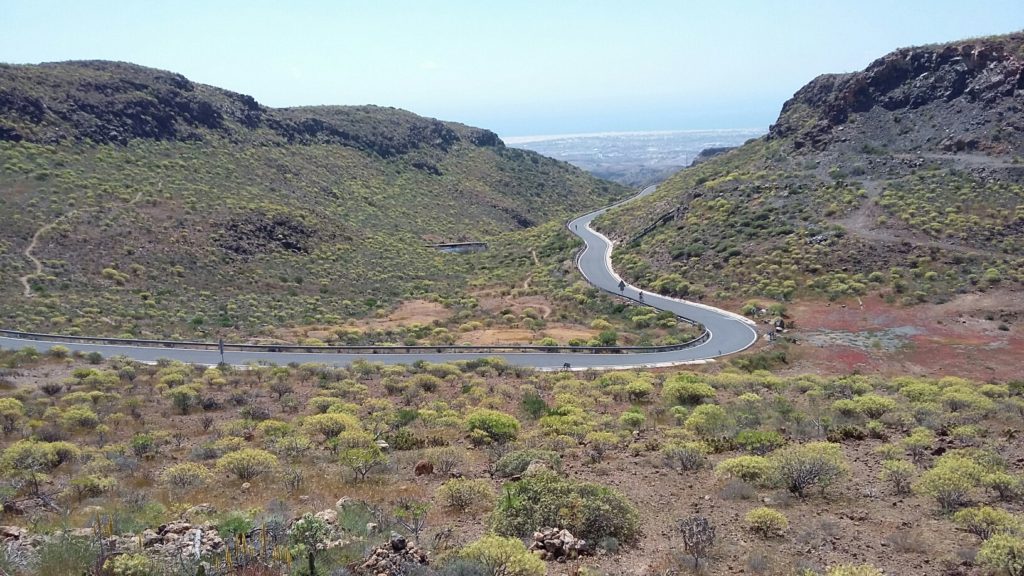
As always the scenery in the area is truly breathtaking and the specific area surrounding Fatagana, for obvious reason is known as ‘The Valley of a thousand palm trees.
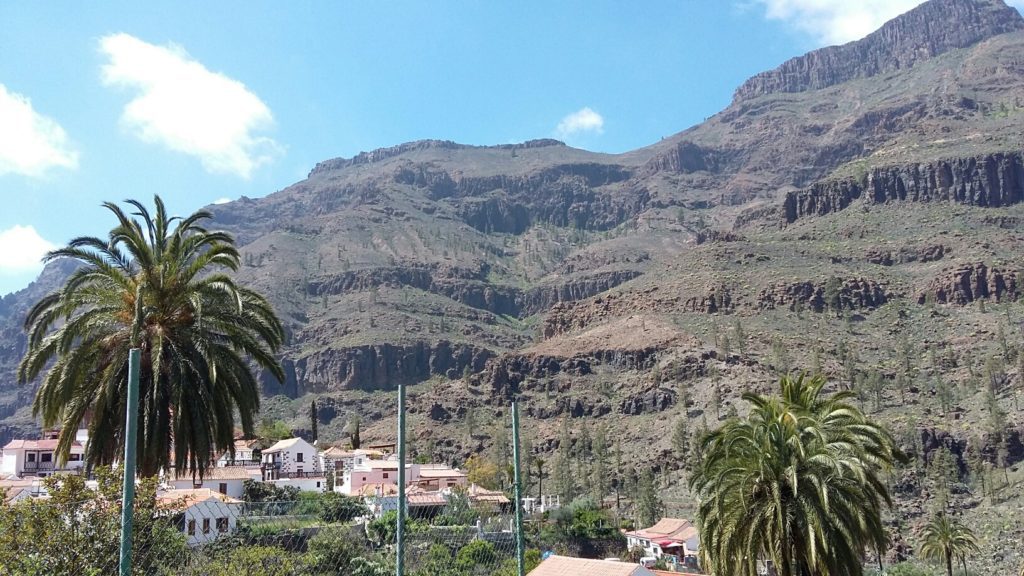
Fatagana is the perfect stop-off to stretch your legs. The houses are very traditional and you will find a couple of cafes and bars for refreshments.

Whilst having a stroll through the streets you will come across souvenir shops, art galleries, an old water mill, and a winery to tempt you to part with your euros. At the central square is the village church, said to be one of the most beautiful on the island.
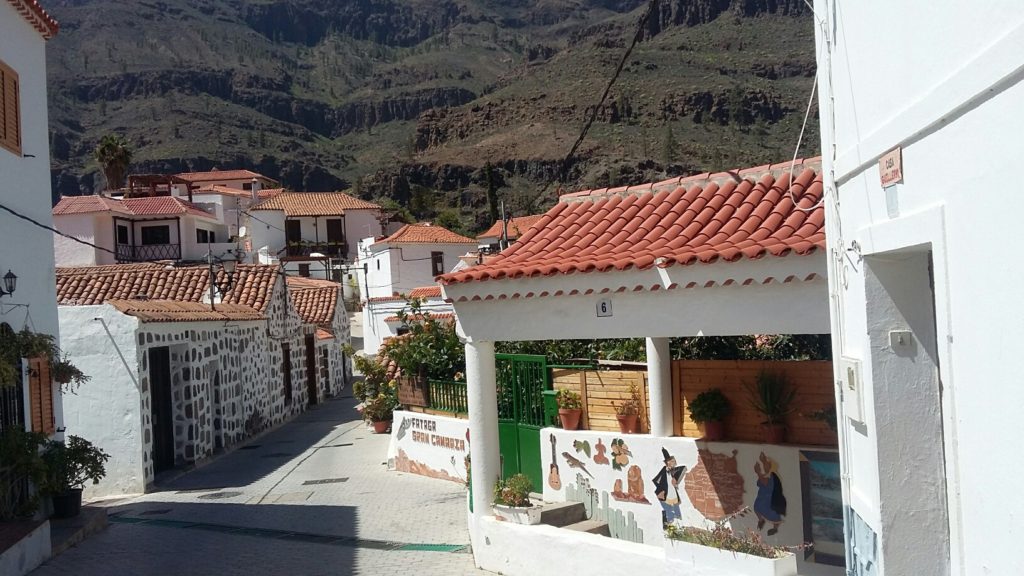
We actually came past the village again later in the evening and it seemed really to have come to life with live music with plenty of laughter, singing, and dancing going on in the main restaurant.
Also worth noting is that just outside Fatagana is a camel park. Here you can meet, kiss (!) and take a camel ride through the surrounding nature reserve.
8 – ARUCAS
Without wanting to sound too repetitive, Arucas is yet another really lovely little town set amongst amazing scenery high in the mountains at 600meters above sea level. It is 12 kilometers from the capital city of Las Palmas.
It was recommended that we visit this town by a friend and it proved to be a great recommendation.
The main attraction, as if often the case in the towns we visited, is its huge imposing church, The Church of San Juan Bautista. The church was built in 1909 and has been sculptured in stone sourced locally in Arucas. Inside the church is beautiful glasswork by the French firm Maumejean et Frères, art by the Canarian painter Cristóbal Hernández de Quintana, and a wooden sculpture of the resting Christ by a local sculptor, Manuel Ramos.

Arucas is world-famous for its rum. Sugar cane has been the main crop grown here since the 15th century, and rum is still produced in the Ron de Arehucas Rum Distillery here. The distillery doubles up as a museum that is open to the public.
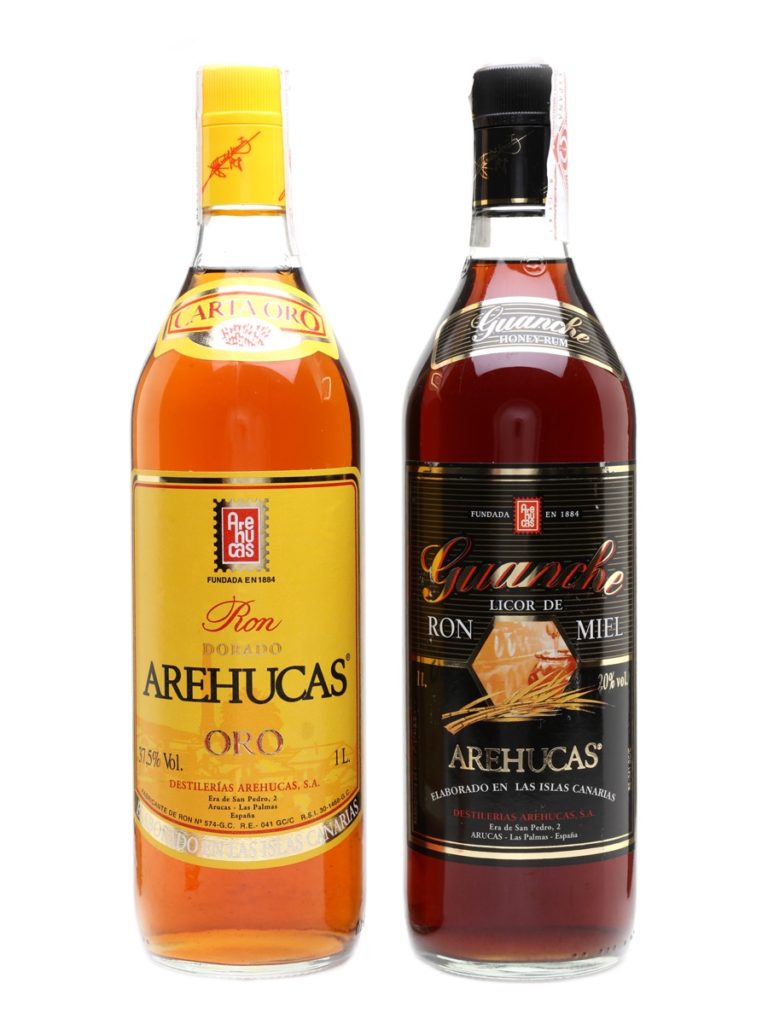
Another interesting attraction is the house and gardens of the Marchioness of Arucas. The gardens are beautiful and open to the public Mondays to Saturdays from 09:00 to 18:00 hours.
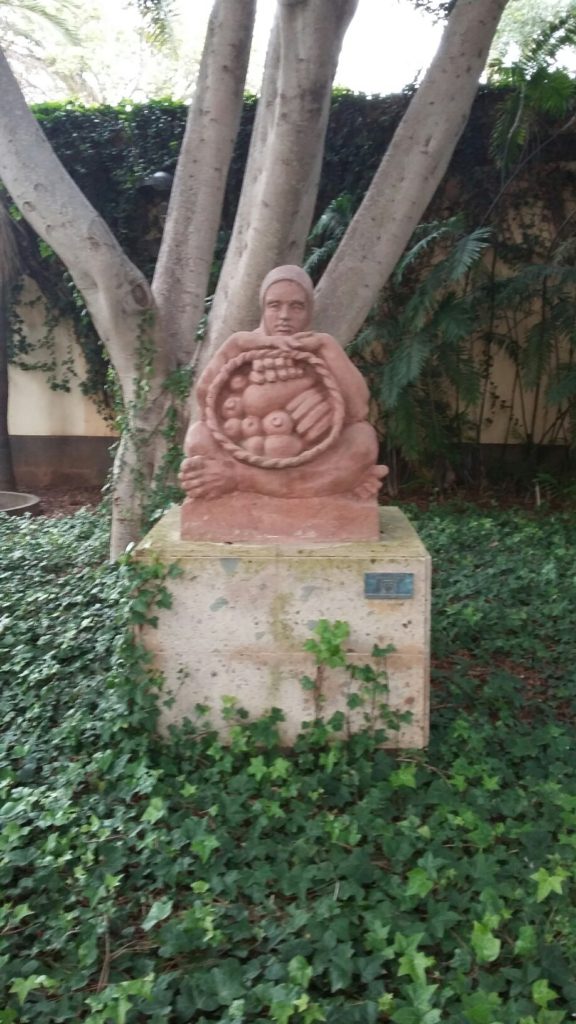
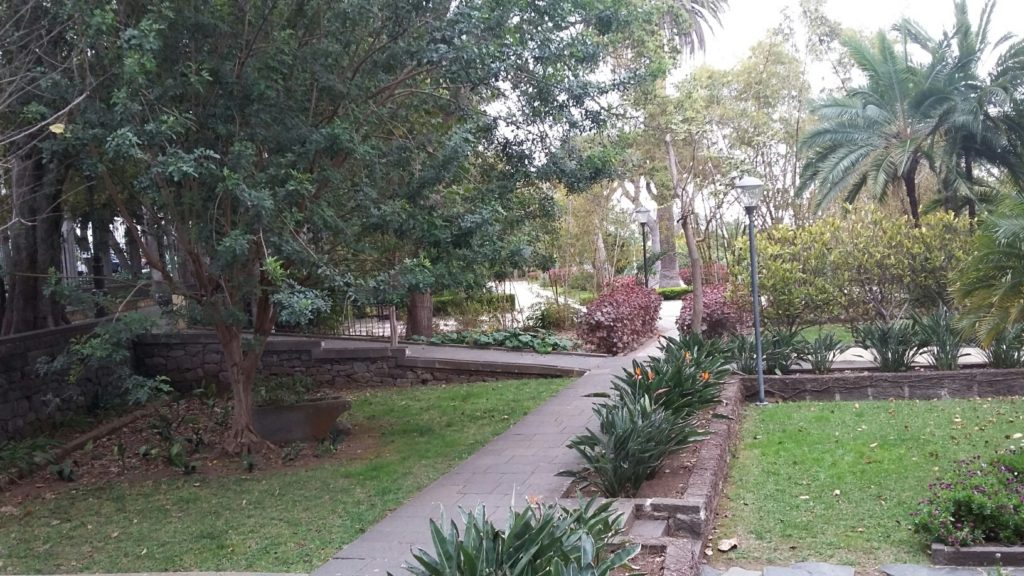
Arucas is a small town but there is lots to see and do here, we highly recommend it
9 – TEJEDA
If I was asked to choose my favourite town in Gran Canaria, It would be a very difficult decision to make – but if forced It would have to be Tejeda.
Standing high in the mountains at approximately 1050 meters above sea level, Tejeda is a one-hour, 45 Kilometer drive from the capital city of Las Palmas. It’s a long and windy drive to get there and will incorporate numerous stops to get photographs of the amazing landscape.
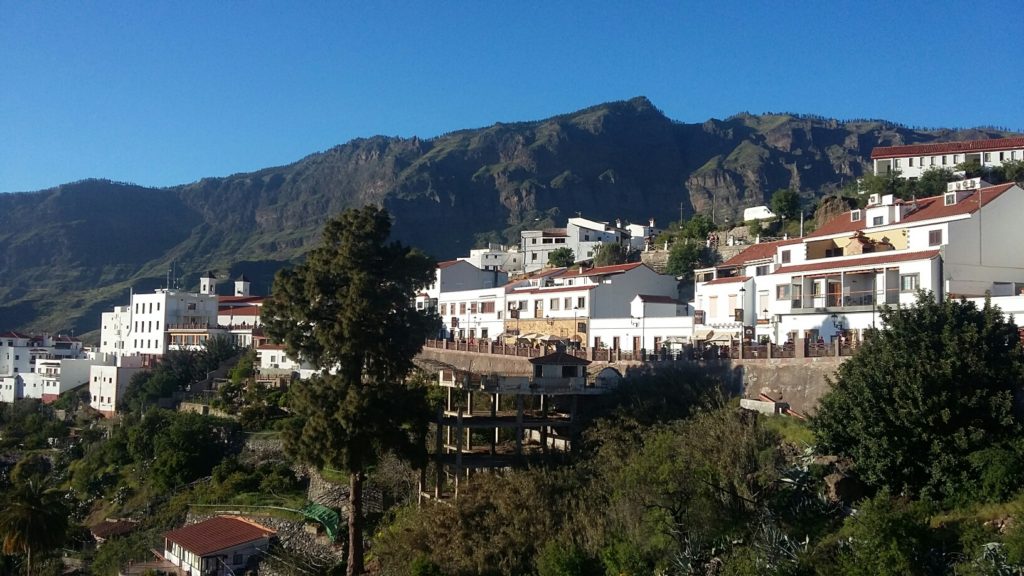
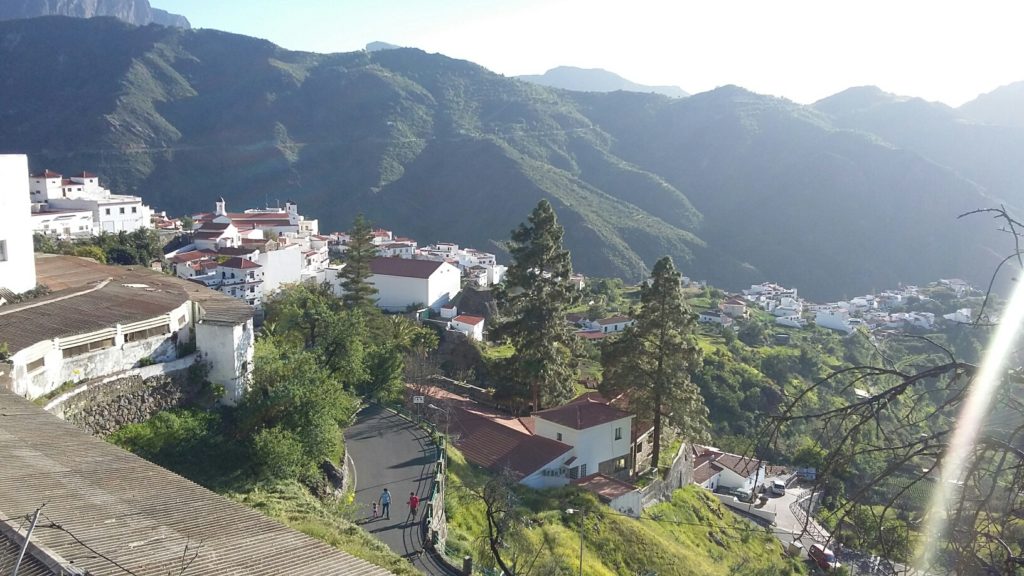
Just before arriving in Tejeda, you will come to an area that is really popular as a meeting point for hikers and cyclists. Here you will find a church, a couple of really popular restaurants, a large free parking area, and a row of stalls selling local merchandise.
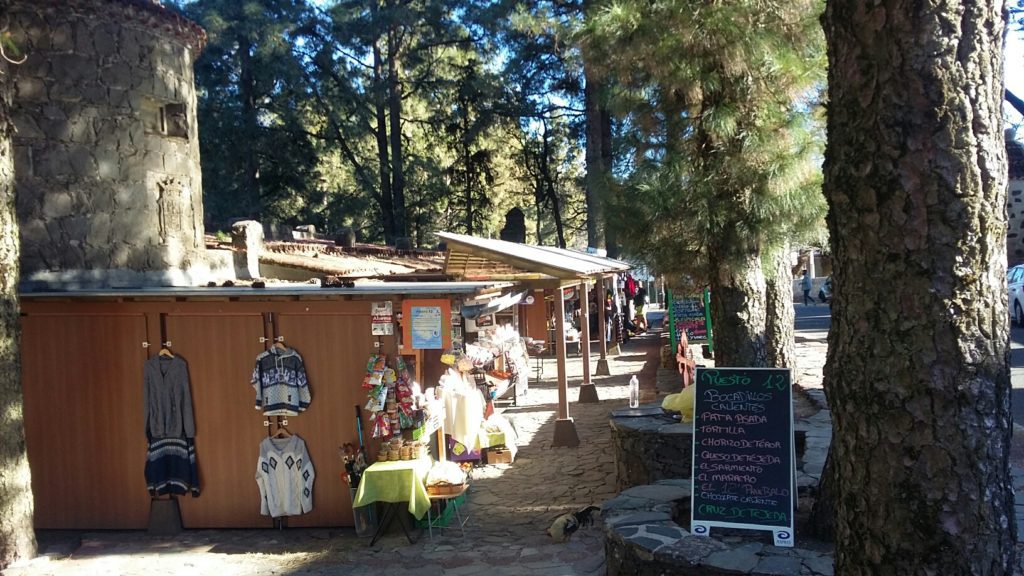
There is also the Cruz de Tejeda ( Tejeda Cross ) Spa hotel situated here. You can use the hotel just for a drink, a meal, or a full spa experience including the use of its open-air heated pool with far-reaching views. Immediately in front of the hotel is the cross of Tejeda itself which marks the central point of Gran Canaria.

From the numerous vantage points, on a clear day, you can observe the natural beauty of Gran Canaria at its best. The mountain Roque Bentayga is to the west and Mount Teide on the neighbouring island of Tenerife can be seen in the distance. Pozo de las Nieves, the island’s highest peak is clearly visible as is the famous symbol of Gran Canaria, The i Roque Nublo. Off to the northeast is Vega de San Mateo.
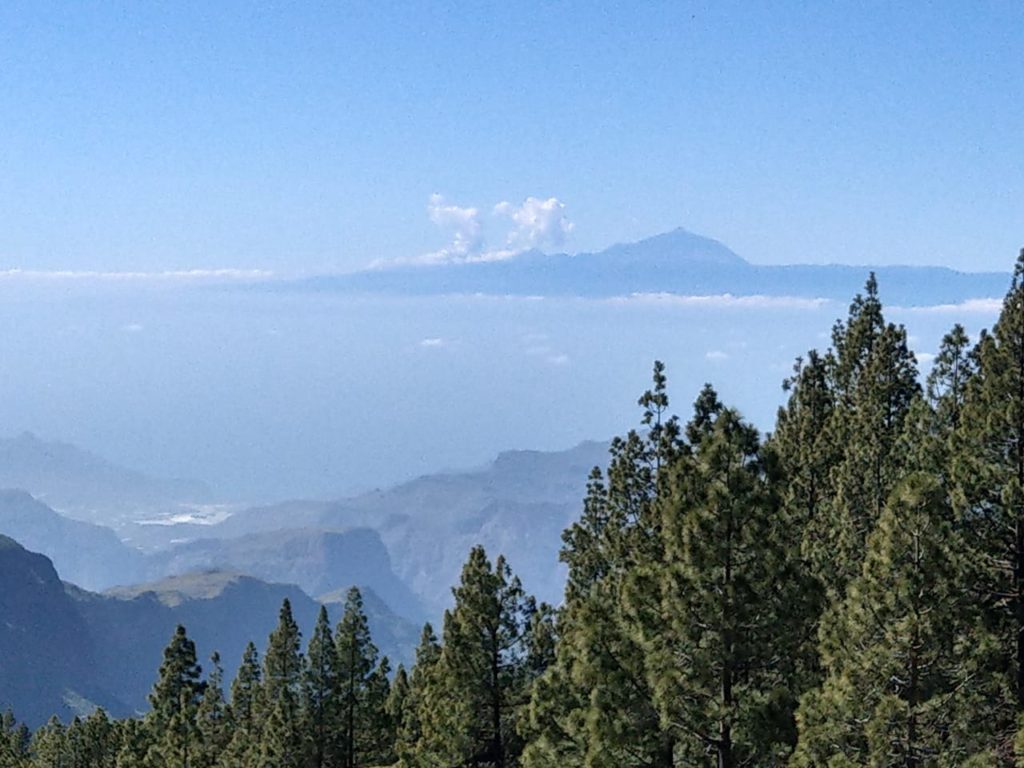
Another 5 kilometers down the mountain will take you to the actual town of Tejeda.

Tejeda is famous for its almond trees and cheese production.
Amongst the varied shops in the village, we came across a sweetshop selling, amongst other things, handmade almond sweets – delicious!
This is yet another beautiful little traditional Canarian town with fabulous views over the mountains.

The buildings in Tejeda are the traditional architecture of the area, built using stone, wood, and shingle.
You can also find cheese shops that sell a huge selection of local cheeses. Many are produced on the premises using traditional techniques.
There is a main street full of bars, cafes, and restaurants.
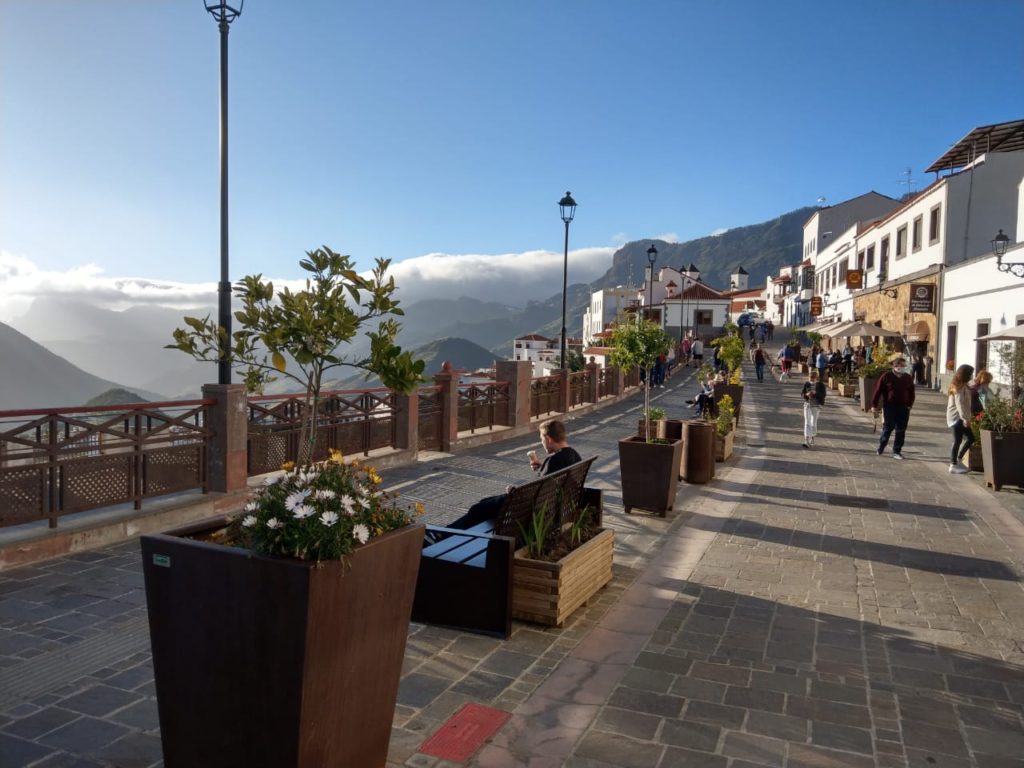
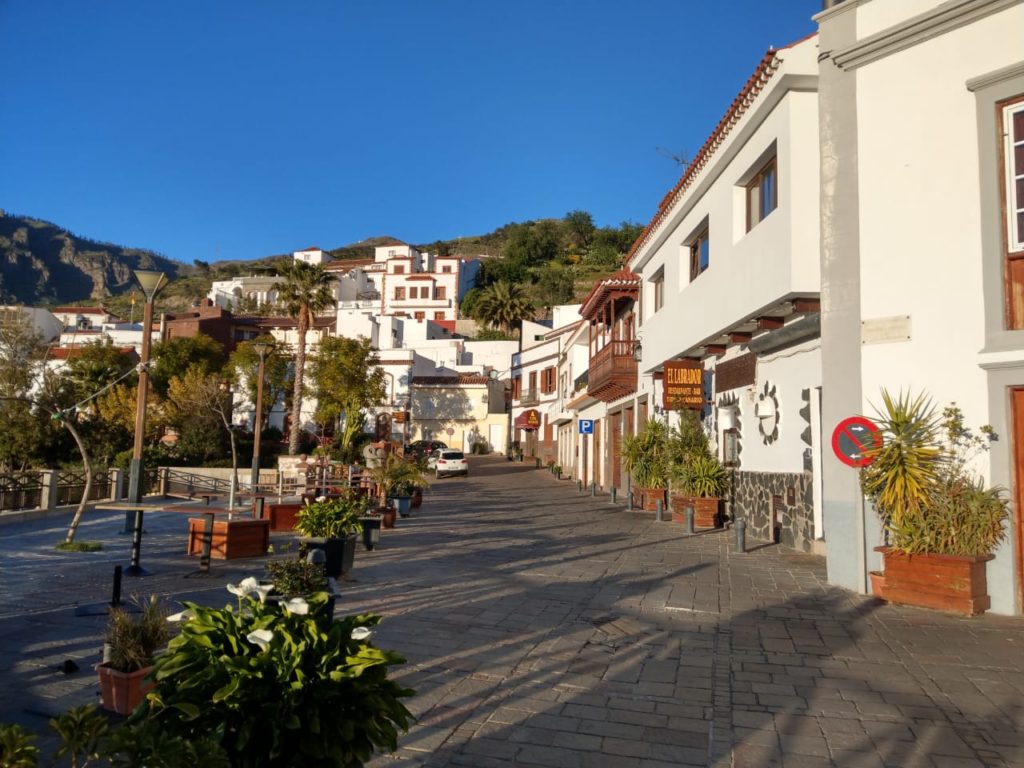
The main viewpoint area has lots of seating to enjoy the magnificent views whilst waiting for the sun to drop behind the mountains.
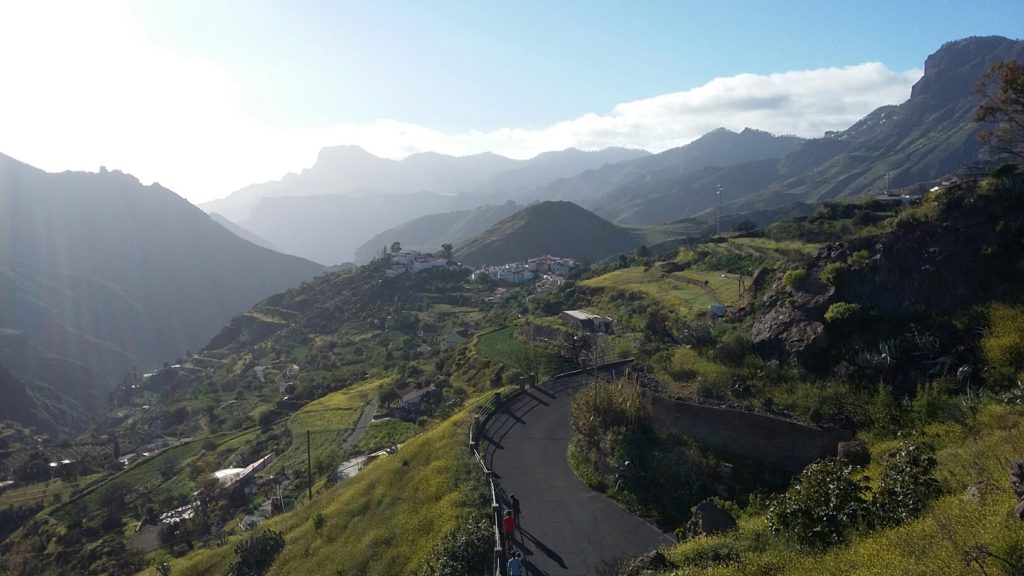


One tip if you do visit, try to leave before it goes dark. The drive back oner the mountain with its windy roads in the dark is a little scary!
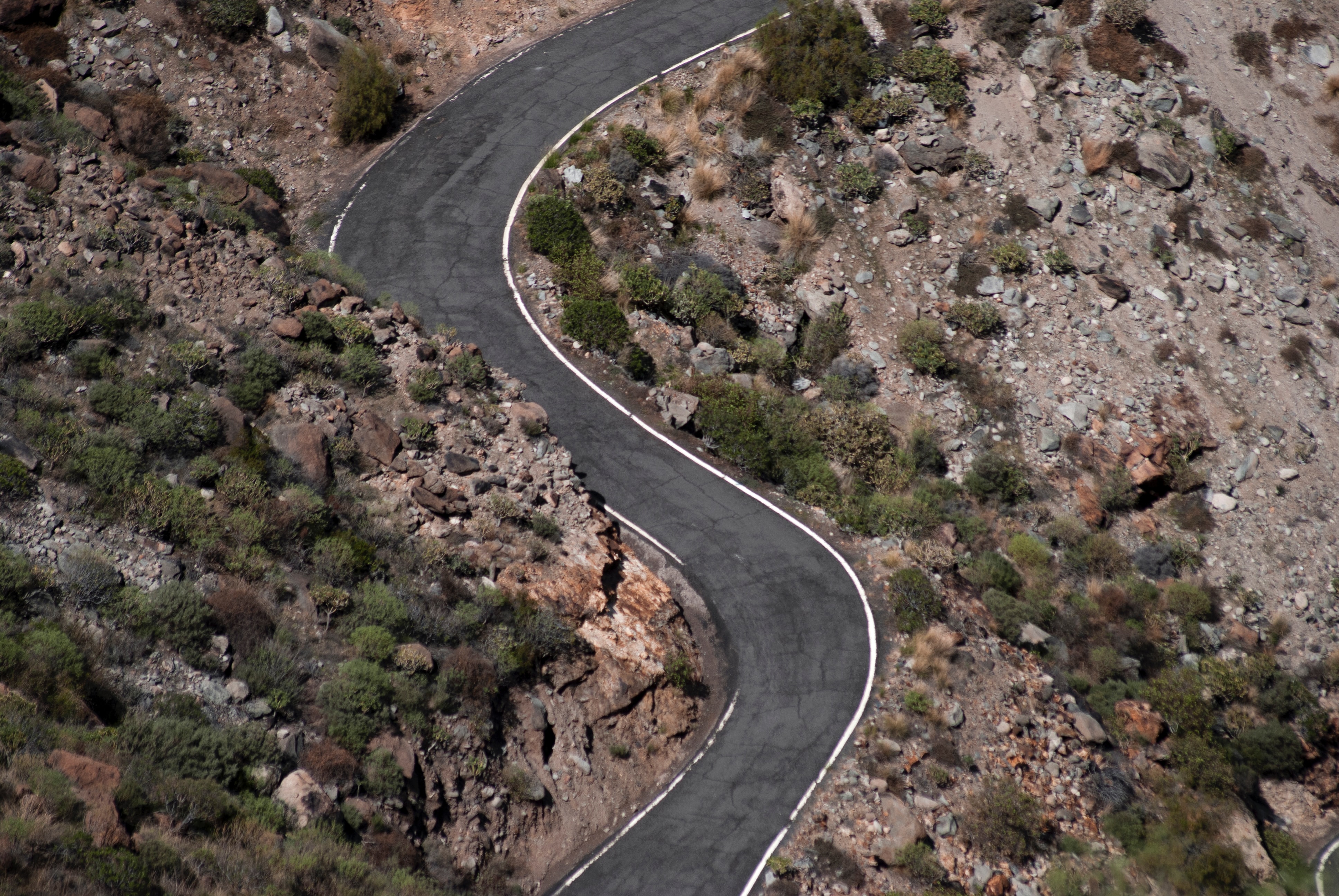
10 – ROQUE NUBLO
Travel a couple more kilometeres from Tejeda and you will reach the Roque Nublo

The Canary Islands are volcanic islands. The Roque Nublo is a protected monument that was formed by a volcanic eruption over four and a half million years ago. Now it stands proudly 1813 meters above sea level, is 80meters tall, and is the second-highest peak on the island.
The monument is a must-see attraction. With a car you can drive most of the way but the last kilometer is along a nature trail. Whilst walking along this trail I saw for the first time in my life a woodpecker actually pecking wood !


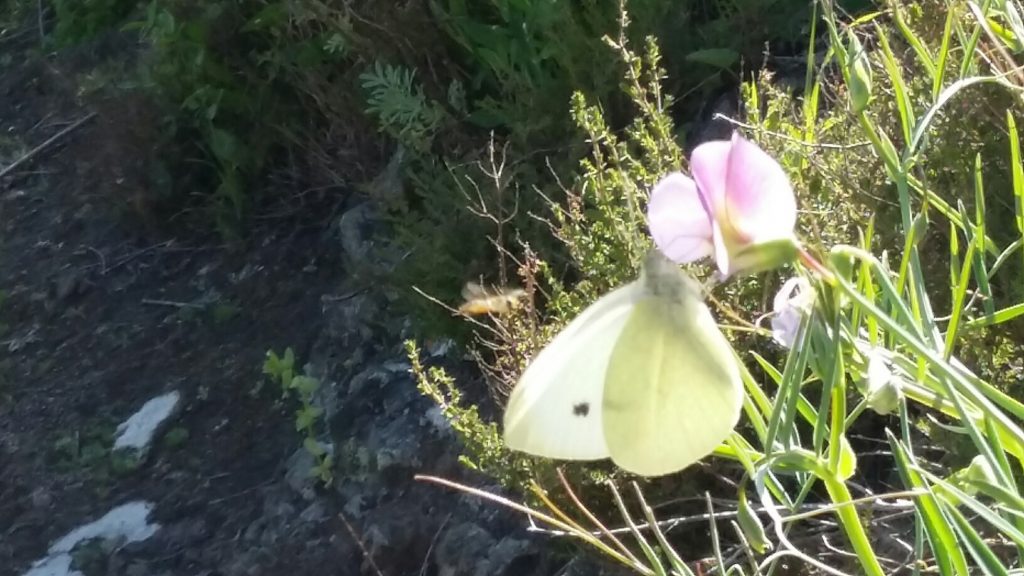
The trek is well worth it and the views, as always in this region are simply breathtaking.
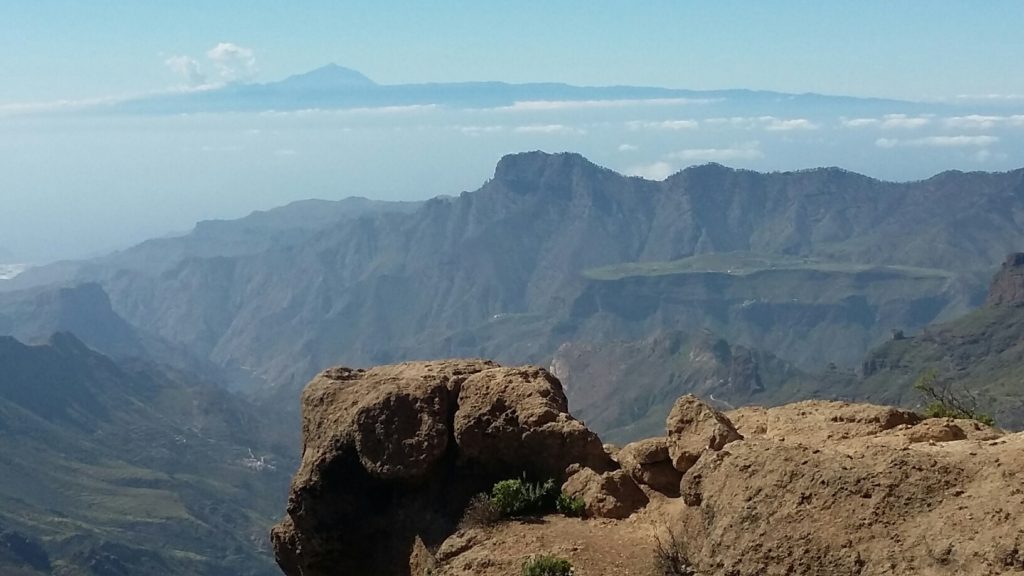
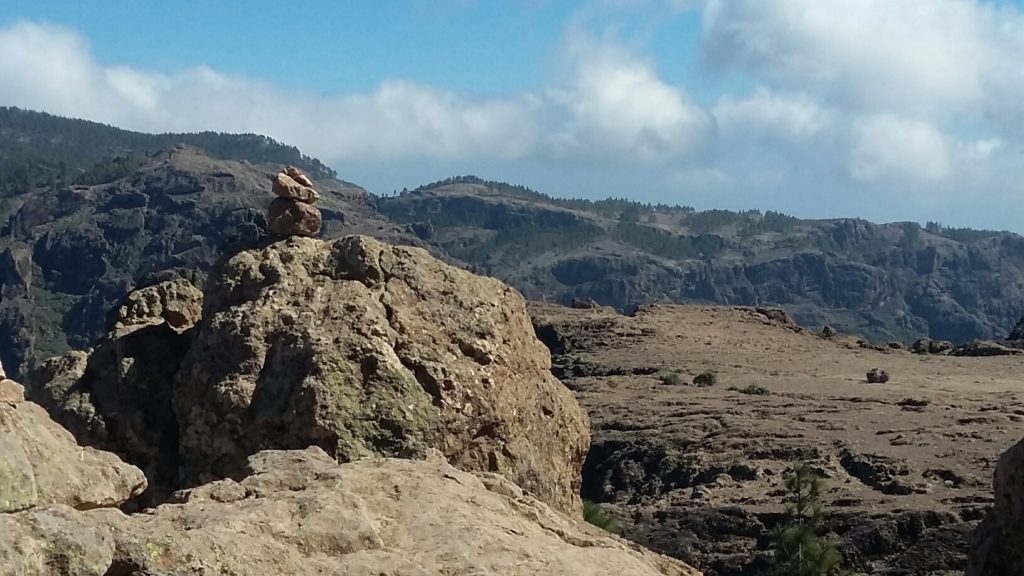

![]()
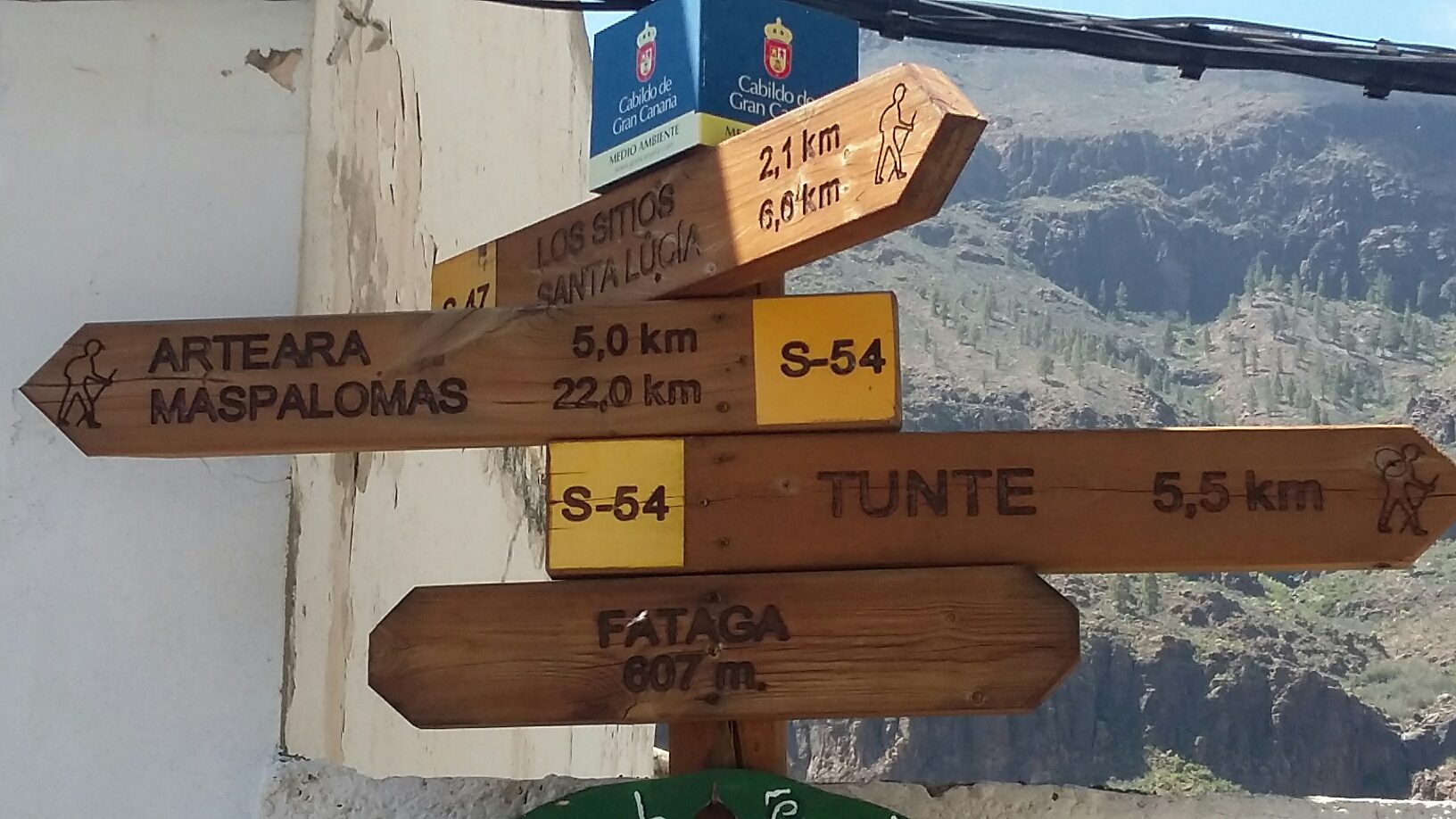

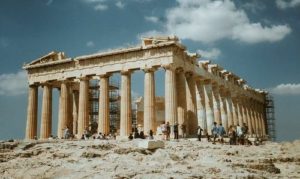
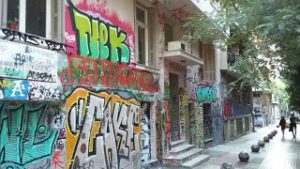
Fabulous blog yet again Colin, great information and beautiful photos. Will miss your adventures, have a safe journey home xx
Thanks Paula. We hope to be on the move again soon!
Well, that was an enjoyable trip from the comfort of my sofa! You both look so well and happy. Fabulous scenery. Can we see some markets, foodstuffs and so on, some time? Always good to see how people live. Are you finding Covid awareness to be very high, and is it affecting what you can do as tourists?
Hi Rachel, we really have been lucky to be able to see some great places. Markets and food on definitely on our list but due to Covid restrictions these have mostly been closed. The Covid awareness has been really high this last 7 months. Especially the mask-wearing has been very strict inside and out which still seems to be much more relaxed in the UK. As tourists, some places have just shut up shop so we could not visit. However, those that were still allowing visitors have been an amazing experience. Visiting The Vatican City and The Acropolis with so few tourists were definite highlights for us.
Brilliant update guys
Very informative and interesting Colin, you’ve certainly done Gran Canaria to the max. I have seen quite a bit of the island myself but can’t remember the place names apart from Playa, Maspalomas and Las Palmas. I do remember driving along part of the east coast heading in a southerly direction in a convertible which made us feel all the more vulnerable on the winding, cliff-hugging road with the sea hundreds of feet below to our left!!
Thank you for sharing xxx
That should’ve said sea to our right…..
Excellent blog post and update! Will bear all this in mind for a future visit!
Keep enjoyin’! x
Love the dunes photo. What a lovely uplifting post. Thanks again for sharing